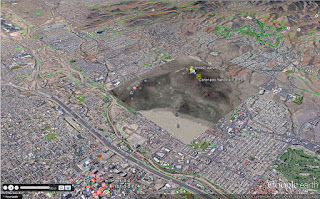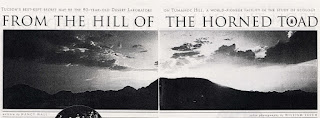“Tumamoc, which is an O'odham word for "regal horned
lizard",[2] was
a home to the ancient Hohokam people. It is the site of the earliest known
trincheras village, consisting of 160 foundations of round stone structures, as
well as large stone perimeter walls.[3] Over
460 petroglyphs and
a prehistoric garden beside the hill provide further evidence of Tumamoc’s
importance to these people.[3] For
long after that time, 1,300 years ago, the site continued to provide resources
to the Tohono O'odham, Akimel
O'odham, and the Hopi. It has also been reported to be a burial site for the Apache and
the O'odham.[3]
Captain Juan Mateo Manje, a Spanish military
commander, wrote the following about Tumamoc Hill after seeing it on one of his
expeditions with Father Kino between 1693 and 1701:[4]
”
|
"We passed in sight of, and around, a mountain where there
are 100 terraces of stone wall in the form of a snail, spiraling to the top.
They say it forms an armory, where in former wars those who gained the heights
first were usually victors. Those who reached the first ring went around to the
second, and as far as was necessary to exhaust the supply of arrows of those below.
Then they came down from the mountain and fell upon their enemies and killed
them..."
Note that Manje refers to "former" wars,
indicating that the fighting took place in prehistoric times (before the
arrival of Europeans). Being that the O'odham are probably descendants of the
Hohokam, it does not seem unreasonable to conclude that the Hohokam, who lived
only a few centuries before Manje's expedition, did as their later relatives
apparently did and used their trincheras to fall upon their enemies and kill
them.[4]
European settlers prized the rock and clay found on the hill
for building in the late 19th century, and early ecologists just after the turn
of the 20th century selected it for the site of the Carnegie Institute's Desert
Laboratory.[3][5] The
hill continues to be a landmark and a sanctuary for the people of Tucson today.
The road up Tumamoc Hill is a popular destination for walking and running. The
entrance to the road up the hill is located across from St. Mary's Hospital on
the south side of Anklam Road. It is open to pedestrians in the early mornings
and evenings. The steep hill provides a strenuous workout, as well as citywide
vistas. Lectures on the unique history and ecology are presented for the public
at the site...”




